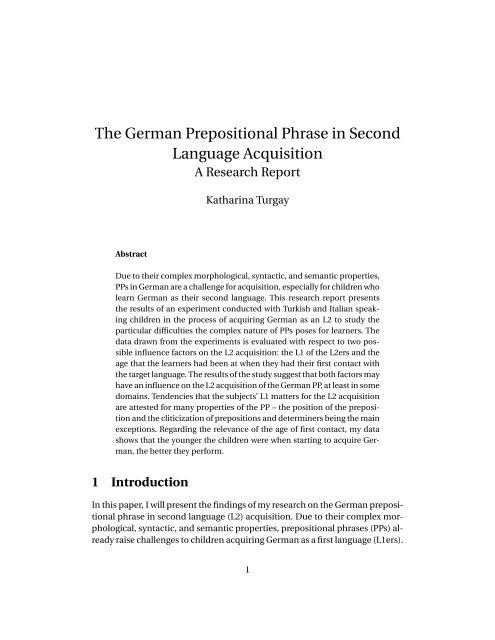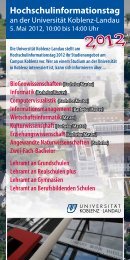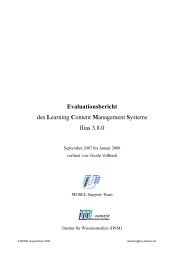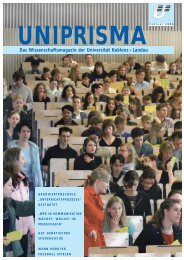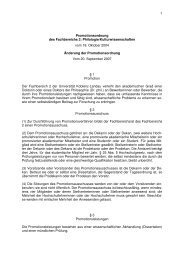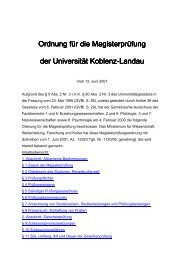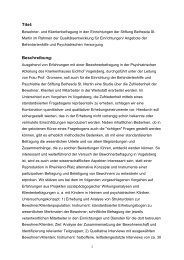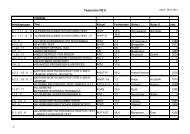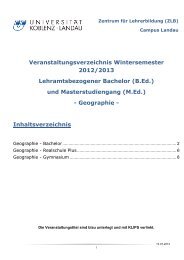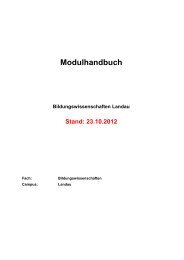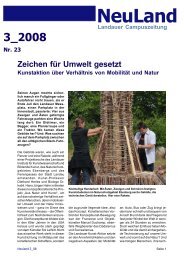The German Prepositional Phrase in Second Language Acquisition
The German Prepositional Phrase in Second Language Acquisition
The German Prepositional Phrase in Second Language Acquisition
You also want an ePaper? Increase the reach of your titles
YUMPU automatically turns print PDFs into web optimized ePapers that Google loves.
<strong>The</strong> <strong>German</strong> <strong>Prepositional</strong> <strong>Phrase</strong> <strong>in</strong> <strong>Second</strong><br />
<strong>Language</strong> <strong>Acquisition</strong><br />
A Research Report<br />
Abstract<br />
Kathar<strong>in</strong>a Turgay<br />
Due to their complex morphological, syntactic, and semantic properties,<br />
PPs <strong>in</strong> <strong>German</strong> are a challenge for acquisition, especially for children who<br />
learn <strong>German</strong> as their second language. This research report presents<br />
the results of an experiment conducted with Turkish and Italian speak<strong>in</strong>g<br />
children <strong>in</strong> the process of acquir<strong>in</strong>g <strong>German</strong> as an L2 to study the<br />
particular difficulties the complex nature of PPs poses for learners. <strong>The</strong><br />
data drawn from the experiments is evaluated with respect to two possible<br />
<strong>in</strong>fluence factors on the L2 acquisition: the L1 of the L2ers and the<br />
age that the learners had been at when they had their first contact with<br />
the target language. <strong>The</strong> results of the study suggest that both factors may<br />
have an <strong>in</strong>fluence on the L2 acquisition of the <strong>German</strong> PP, at least <strong>in</strong> some<br />
doma<strong>in</strong>s. Tendencies that the subjects’ L1 matters for the L2 acquisition<br />
are attested for many properties of the PP – the position of the preposition<br />
and the cliticization of prepositions and determ<strong>in</strong>ers be<strong>in</strong>g the ma<strong>in</strong><br />
exceptions. Regard<strong>in</strong>g the relevance of the age of first contact, my data<br />
shows that the younger the children were when start<strong>in</strong>g to acquire <strong>German</strong>,<br />
the better they perform.<br />
1 Introduction<br />
In this paper, I will present the f<strong>in</strong>d<strong>in</strong>gs of my research on the <strong>German</strong> prepositional<br />
phrase <strong>in</strong> second language (L2) acquisition. Due to their complex morphological,<br />
syntactic, and semantic properties, prepositional phrases (PPs) already<br />
raise challenges to children acquir<strong>in</strong>g <strong>German</strong> as a first language (L1ers).<br />
1
For children <strong>in</strong> second language acquisition (L2ers), they should pose even<br />
more obstacles. In order to exam<strong>in</strong>e the L2 acquisition of the PP, I ran experiments<br />
with Turkish and Italian speak<strong>in</strong>g children. My ma<strong>in</strong> aim is to present<br />
the empirical results of the experiment run, <strong>in</strong>stead of <strong>in</strong>terpret<strong>in</strong>g them with<br />
respect to a specific framework of language acquisition. <strong>The</strong>refore, this paper<br />
is meant to be a research report rather than a deep analysis.<br />
<strong>The</strong> structure of this paper is as follows. In the next section, I will present<br />
two factors that can have an <strong>in</strong>fluence on how the L2 acquisition of the <strong>German</strong><br />
PP proceeds and which may lead to various difficulties. <strong>The</strong>se factors are (i)<br />
the L1 of the L2ers and (ii) the age that the learners had been at when they<br />
had their first contact with the target language (TL). From these factors, I will<br />
derive various predictions for my experiments, especially what difficulties can<br />
be expected for which subject group. For predict<strong>in</strong>g any <strong>in</strong>ference of the L1,<br />
I will also sketch the structure of the PPs <strong>in</strong> <strong>German</strong>, Italian, and Turkish. In<br />
section 3, I will illustrate the experiment design and present the subjects and<br />
the different tasks I used to elicit my data. In section 4, I will discuss the results<br />
of my experiments with respect to the two <strong>in</strong>fluence factors. I will conclude<br />
with a short summary.<br />
2 Factors of Influence<br />
I will evaluate the results of my study with respect to two possible factors of<br />
<strong>in</strong>fluence. First, I exam<strong>in</strong>e the question of whether the L1 of the subjects – that<br />
is, Turkish or Italian – has any relevance for the acquisition of PPs <strong>in</strong> the TL. An<br />
<strong>in</strong>fluence of L1 on the acquisition of the L2 morpho-syntax has already been<br />
attested by various studies, especially with<strong>in</strong> the nom<strong>in</strong>al doma<strong>in</strong> but also for<br />
the PP. For <strong>in</strong>stance, Pfaff (1984: 294) reports that <strong>in</strong> a study with Turkish and<br />
Greek subjects, prepositions are frequently omitted by learners of both L1s.<br />
However, concern<strong>in</strong>g a possible transfer, she also claims “the grammatical categories<br />
of the L1 Turkish play no role or only a limited role <strong>in</strong> the development<br />
of <strong>German</strong> L2” (Pfaff 1992: 293). In contrast to this claim, when compar<strong>in</strong>g<br />
Turkish and Polish L2ers with respect to the question of whether prepositions<br />
are used, Kuhberg (1990: 27) observes a slower acquisition rate for the Turkish<br />
subjects. For determ<strong>in</strong>ers, studies by Parodi (1998: 181) and Jeuk (2006) document<br />
higher omission rates for Turkish L2ers than for learners with a Roman<br />
L1. For the development of gender, which is realized at the determ<strong>in</strong>er <strong>in</strong> <strong>German</strong>,<br />
Wegener (1993: 106) observes difficulties for those learners whose L1 exhibits<br />
no gender, like Turkish, while children with Russian and Polish L1 have<br />
2
lesser problems with gender. Pfaff & Portz (1980: 87) make the same observation<br />
for Turkish learners when compared to Greek children.<br />
<strong>The</strong> second possible factor of <strong>in</strong>fluence I exam<strong>in</strong>e is the relevance of the<br />
age that the L2ers were at when they came <strong>in</strong>to first contact with their L2. A<br />
difference between early <strong>in</strong>fantile language acquisition and child language acquisition<br />
has been established for several aspects of language development.<br />
For example, Bast (2003: 255ff) studies two Russian girls, 8 and 14 years old,<br />
and observes that after a period of 16 months after start<strong>in</strong>g to learn <strong>German</strong>,<br />
the younger girl does not omit determ<strong>in</strong>ers, while the older one still does. For<br />
other doma<strong>in</strong>s of L2 acquisition, several studies show that younger L2ers have<br />
an advantage over older ones, see e.g. Dimroth (2007) for the acquisition of<br />
word order. However, Pienemann (1981) claims that the age at the beg<strong>in</strong>n<strong>in</strong>g<br />
of the L2 acquisition does not have any <strong>in</strong>fluence on the quality of the development<br />
of the L2 but on the rate of acquisition. In contrast, Dimroth (2007: 134)<br />
notices similar acquisition rates for two girls that were at an age of 8 and 14<br />
when they had their first contact with <strong>German</strong>. Rothweiler (2006) and Thoma<br />
& Tracy (2006) both detect that the <strong>German</strong> verb placement shows the same<br />
acquisition process <strong>in</strong> early child acquisition as <strong>in</strong> the L1 acquisition of the<br />
<strong>German</strong> verb syntax. Given these contrary f<strong>in</strong>d<strong>in</strong>gs, Dimroth (2007: 134) notes<br />
that the question of whether and how age is a relevant factor for L2 acquisition<br />
cannot be predicted <strong>in</strong> general, but has to be evaluated for each matter of<br />
acquisition separately.<br />
At this po<strong>in</strong>t, I would like to stress aga<strong>in</strong> that the data <strong>in</strong> section 4 are not<br />
<strong>in</strong>terpreted aga<strong>in</strong>st the background of a particular theoretic framework. <strong>The</strong>refore,<br />
I will keep the predictions and hypothesis simple and relatively general.<br />
2.1 Relevance of the L1 of the subjects<br />
<strong>The</strong> first hypothesis I will exam<strong>in</strong>e when evaluat<strong>in</strong>g the data of my study concerns<br />
the relation between the L1 of the subjects and the TL of the L2 acquisition.<br />
(H1) <strong>The</strong> L1 of the L2ers can have positive or negative <strong>in</strong>fluence on the acquisition<br />
of the TL.<br />
This hypothesis concerns the proficiency <strong>in</strong> usage as well as the acquisition<br />
rate and language development. In order to predict any transfer from L1 to L2, I<br />
will first sketch the structure of the PP <strong>in</strong> the TL, followed by a short description<br />
of the PP <strong>in</strong> Turkish and Italian.<br />
3
<strong>The</strong> term preposition has a narrow and a broad sense. In the broad one, it<br />
is equivalent to adposition and does not refer to the position <strong>in</strong> which the adposition<br />
shows up with respect to its complement. <strong>The</strong> more frequent sense<br />
however is the narrow one <strong>in</strong> which it refers to adpositions that precede their<br />
argument. <strong>The</strong> prototypical <strong>German</strong> PP is headed by a preposition <strong>in</strong> the narrow<br />
sense. Prepositions <strong>in</strong> <strong>German</strong> can select a variety of other phrases as their<br />
complement, e.g. determ<strong>in</strong>er phrases (DPs), adjective phrases (APs), adverbial<br />
phrases (AdvPs), verbal phrases (VPs) or sentences (CPs). <strong>The</strong>refore, follow<strong>in</strong>g<br />
Jackendoff (1973), we can assume the follow<strong>in</strong>g generalized phrase structure<br />
for PPs <strong>in</strong> <strong>German</strong>:<br />
(1) a. PP → [ P [ XP ] ]<br />
b. XP ∈ {DP, AP, AdvP, PP, VP, CP}<br />
However, the prototypical <strong>German</strong> PP is one <strong>in</strong> which the preposition selects<br />
a DP, which <strong>in</strong> turn consists of a determ<strong>in</strong>er and a noun, as illustrated by the<br />
follow<strong>in</strong>g example:<br />
(2) a. Ger. Tom<br />
Tom<br />
schwimmt<br />
swims<br />
[PP <strong>in</strong> [DP die<br />
P DET<br />
Engl. Tom swims <strong>in</strong>to the bay.<br />
Bucht. ] ]; PP → [ P [ DP ] ]<br />
bay<br />
In <strong>German</strong>, prepositions govern the case of the DP they subcategorize. For <strong>in</strong>stance,<br />
<strong>in</strong> the follow<strong>in</strong>g examples, the preposition mit ‘with’ <strong>in</strong> (3a) assigns dative<br />
case to its complement DP, while <strong>in</strong> (3b), the preposition ohne ‘without’<br />
selects for an accusative DP. <strong>The</strong>re are also prepositions like statt ‘<strong>in</strong>stead of’<br />
<strong>in</strong> (3c) that govern genitive case. 1<br />
(3) a. Ger. Sie verreist<br />
She travels<br />
[PP mit<br />
P<br />
ihrer Familie.<br />
DET family<br />
Engl. She travels with her family.<br />
b. Ger. Sie verreist [PP ohne ihre Familie.<br />
She travels P DET family<br />
]DAT<br />
]ACC<br />
c.<br />
Engl. She travels without her family.<br />
Ger. [PP Statt ihrer Familie ]GEN nimmt sie ihre Freunde mit.<br />
P DET family takes she her friends with<br />
Engl. Instead of her family, she takes her friends with her.<br />
1 For further references regard<strong>in</strong>g the syntax as well as the semantics of prepositions, cf.<br />
Wunderlich 1984.<br />
4
Like the majority of prepositions, these are prepositions with fixed case assignment.<br />
<strong>The</strong> relationship between the case they assign and their semantics is<br />
mostly arbitrary. <strong>The</strong>refore, the case governed by a certa<strong>in</strong> preposition cannot<br />
easily be predicted and must be learned separately for each preposition.<br />
However, there is a class of (mostly local) two-way prepositions that can either<br />
govern the accusative or dative case. For these prepositions, the case used<br />
systematically corresponds to semantic differences and hence is semantically<br />
motivated. For <strong>in</strong>stance, the preposition <strong>in</strong> can either select a dative or an accusative<br />
DP.<br />
(4) a. Ger. Die K<strong>in</strong>der s<strong>in</strong>d<br />
<strong>The</strong> children are<br />
[PP <strong>in</strong> [DP der<br />
P DET<br />
[NP Schule. ]] DAT]<br />
school<br />
Engl. <strong>The</strong> children are <strong>in</strong> the school.<br />
b. Ger. Die K<strong>in</strong>der gehen [PP <strong>in</strong> [DP die [NP Schule. ]] ACC]<br />
<strong>The</strong> children go P DET school<br />
Engl. <strong>The</strong> children go <strong>in</strong>to the school.<br />
A PP with a preposition select<strong>in</strong>g a dative DP receives a local static <strong>in</strong>terpretation<br />
as <strong>in</strong> (4a). In this case, the <strong>German</strong> <strong>in</strong> can be translated by English <strong>in</strong>.<br />
However, if the same preposition has an accusative argument as <strong>in</strong> (4b), it is<br />
<strong>in</strong>terpreted directionally and implies a change <strong>in</strong> position, correspond<strong>in</strong>g to<br />
English <strong>in</strong>to. More examples of <strong>German</strong> two-prepositions <strong>in</strong>clude an, auf, <strong>in</strong>,<br />
h<strong>in</strong>ter, neben, über, unter, vor, and zwischen. 2<br />
With<strong>in</strong> the DP, there is agreement between the determ<strong>in</strong>er and the noun<br />
with respect to case, gender, and number.<br />
(5) a. Ger. Er spielt<br />
He plays<br />
]] DAT.FEM.SG]<br />
[PP mit [DP der<br />
[NP Schwester.<br />
P DET.DAT.FEM.SG sister.DAT.FEM.SG<br />
Engl. He plays with the sister.<br />
However, gender is an <strong>in</strong>herent feature of the noun and only observable at the<br />
determ<strong>in</strong>er. For most noun classes, case is also only marked at the determ<strong>in</strong>er,<br />
except for the genitive case.<br />
2 Furthermore, two-way prepositions also depend on the semantics of the ma<strong>in</strong> verb of the<br />
sentence. For this, Leys (cf. 1989).<br />
5
To produce a PP, the children on the one hand have to choose a preposition<br />
that is suitable to express the <strong>in</strong>tended semantics. 3 On the other hand, they<br />
have to correctly use a DP, which is selected by the preposition <strong>in</strong> question and<br />
whose case is governed by the preposition. <strong>The</strong> case has to be realized on the<br />
determ<strong>in</strong>er and, if present, on adjectives. If the case governed by the preposition<br />
is the genitive case, it is also marked at the noun. In addition, there is<br />
agreement with<strong>in</strong> the DP between the determ<strong>in</strong>er, adjectives and the noun<br />
concern<strong>in</strong>g gender and number. <strong>The</strong>refore, there are various features to be<br />
marked. <strong>The</strong> many possible comb<strong>in</strong>ations of features lead to many syncretic<br />
forms with<strong>in</strong> the <strong>German</strong> nom<strong>in</strong>al <strong>in</strong>flection paradigm.<br />
In <strong>German</strong>, determ<strong>in</strong>ers can be cliticized to prepositions (Hartmann 1978;<br />
Schmöe 2004). This holds for dative and accusative forms of s<strong>in</strong>gular def<strong>in</strong>ite<br />
articles (6a). Regard<strong>in</strong>g the fem<strong>in</strong><strong>in</strong>e article, only the preposition zu can be<br />
cliticized with the dative article. 4<br />
(6) a. Ger. im/<strong>in</strong> dem<br />
P+DET.DAT.SG<br />
Engl. <strong>in</strong> the forest<br />
b. Ger. zur/zu der<br />
Wald<br />
forest<br />
P+DET.DAT.FEM.SG<br />
Engl. to school<br />
Schule<br />
school<br />
In Italian, there are prepositions like <strong>in</strong> <strong>German</strong>. <strong>The</strong>y are positioned <strong>in</strong> front of<br />
the DP. S<strong>in</strong>ce there is no case mark<strong>in</strong>g on determ<strong>in</strong>ers, nouns and adjectives,<br />
there is no overt case mark<strong>in</strong>g <strong>in</strong> a prototypically Italian PP and therefore, no<br />
case assignment of the preposition to its complement DP can be observed.<br />
Nouns bear grammatical gender, but <strong>in</strong> contrast to <strong>German</strong>, there are only two<br />
genders: mascul<strong>in</strong>e and fem<strong>in</strong><strong>in</strong>e. <strong>The</strong> neuter that exists <strong>in</strong> <strong>German</strong> is miss<strong>in</strong>g<br />
<strong>in</strong> Italian. In the DP selected by the preposition, there is agreement with<br />
respect to gender and number:<br />
(7) Ital. [PP con [DP questo ragazzo ] ]<br />
P DET.MASK.SG boy.MASK.SG<br />
Engl. with the boy<br />
3For references on the semantics of local prepositions, Herweg (cf. 1989); Wunderlich &<br />
Herweg (1991).<br />
4For semantic differences between cliticized and unclitized form, cf. Nübl<strong>in</strong>g (2005).<br />
6
<strong>The</strong>re are no two-way prepositions <strong>in</strong> Italian, while cliticizations of determ<strong>in</strong>ers<br />
to prepositions are frequent and are obligatory <strong>in</strong> many contexts:<br />
(8) Ital. andare alla<br />
go P+DET<br />
posta<br />
Post<br />
Engl. go to the post office<br />
In contrast to both <strong>German</strong> and Italian, there is no gender <strong>in</strong> Turkish. Furthermore,<br />
there are no def<strong>in</strong>ite articles <strong>in</strong> the syntactic sense. <strong>The</strong> Turkish DP 5<br />
shows case agreement between optional pronouns <strong>in</strong> determ<strong>in</strong><strong>in</strong>g usage and<br />
the noun, but not between the noun and a possible adjective. Three of the six<br />
suffixes which mark case can build phrases which can best be translated by<br />
prepositional phrases. <strong>The</strong>se suffixes are the locative, which expresses a local<br />
mean<strong>in</strong>g, the dative, which expresses a directional mean<strong>in</strong>g, and the ablative,<br />
which yields a source-related mean<strong>in</strong>g:<br />
(9) a. Turk. ev<br />
house<br />
-de<br />
-LOK<br />
Engl. <strong>in</strong>/at/by/. . . the house<br />
b. Turk. ev -e<br />
house -DAT<br />
Engl. <strong>in</strong>to/to the house<br />
c. Turk. ev -den<br />
house -ABL<br />
Engl. from the house<br />
<strong>The</strong>se examples show that the English PP consists of a preposition and a DP<br />
with a determ<strong>in</strong>er and a noun, 6 while the Turkish equivalent only consists of a<br />
noun with a case suffix without any determ<strong>in</strong>er or observable gender. <strong>The</strong> semantics<br />
of the Turkish expression is very underspecified, but there is another<br />
possibility to produce a phrase which corresponds to an English PP. <strong>The</strong>se<br />
phrases <strong>in</strong>volve a postposition which is positioned after the noun and governs<br />
a fixed case at the noun:<br />
(10) Turk. [PP San -a kar¸sı<br />
PRO.2.sg -DAT POST<br />
] de˘gil -ler.<br />
not<br />
5Concern<strong>in</strong>g the question of whether there are determ<strong>in</strong>ers <strong>in</strong> Turkish, Arslan Kechriotis<br />
(cf. 2009).<br />
6In the <strong>German</strong> PP, there is also agreement <strong>in</strong> case, gender and number <strong>in</strong> the DP.<br />
7
Engl. <strong>The</strong>y’re not aga<strong>in</strong>st you. (Göksel & Kerslake 2005: 246)<br />
In this example, the postposition kar¸sı assigns the dative to the complement<br />
pronoun. But due to the lack of def<strong>in</strong>ite articles <strong>in</strong> Turkish, these PPs 7 consist<br />
only of the case marked (pro)noun and the postposition.<br />
<strong>The</strong>re are other k<strong>in</strong>ds of postpositions <strong>in</strong> Turkish which are called ‘secondary<br />
postpositions’ <strong>in</strong> contrast to ‘primary postpositions’. <strong>The</strong>se postpositions<br />
consist of a local noun bear<strong>in</strong>g a possessive suffix and one of the three<br />
just illustrated case suffixes, which determ<strong>in</strong>e the semantics of the PP. Independent<br />
from the case of the postposition itself, all secondary postpositions<br />
govern the genitive:<br />
(11) a. Turk. [PP Ev -<strong>in</strong> iç-i-nde<br />
] ne<br />
house- GEN POST(Interior.POSS-1.-SG.LOK) what<br />
var?<br />
is<br />
Engl. What is <strong>in</strong>side the house?<br />
b. Turk. Topu [PP masa -n<strong>in</strong> alt-ın-a<br />
]<br />
ball table -GEN POST(bottomside.POSS-1.-SG.DAT)<br />
attı.<br />
threw<br />
Engl. He threw the ball under the table.<br />
In these examples, the case of the postpositions changes with the semantics of<br />
the PP. This is rem<strong>in</strong>iscent of the <strong>German</strong> two-way prepositions. <strong>The</strong> difference<br />
regards the expression where case changes. While <strong>in</strong> Turkish the case suffix<br />
changes on the postposition itself, the case changes on the complement noun<br />
<strong>in</strong> <strong>German</strong>.<br />
Given these structural differences between the <strong>German</strong>, Italian and Turkish<br />
PP, I will now make some predictions for my experiments based on a possible<br />
<strong>in</strong>fluence between the L1 of the L2ers and the TL. For the Turkish subjects, I expect<br />
more problems than for the Italian subjects with respect to the l<strong>in</strong>earization<br />
of the preposition, s<strong>in</strong>ce Turkish uses postpositions if any, while Italian<br />
has obligatory prepositions. <strong>The</strong> same contrast also leads to the expectation<br />
that the Turkish subjects use less prepositions than the Italians subjects do <strong>in</strong><br />
the first place and, if a preposition is chosen, that it may be harder for the Turkish<br />
children to choose the correct one. In a similar ve<strong>in</strong>, if the subjects’ L1 has<br />
an <strong>in</strong>fluence on their performance <strong>in</strong> the TL, we can expect the Turkish L2ers to<br />
have more problems with us<strong>in</strong>g a determ<strong>in</strong>er, s<strong>in</strong>ce their L1 does not exhibit<br />
these functional categories <strong>in</strong> a systematic way as Italian or <strong>German</strong> do. Re-<br />
7 Which also means ‘postpositional’ phrase <strong>in</strong> this article.<br />
8
lated to this is the prediction that mark<strong>in</strong>g of gender on the determ<strong>in</strong>er poses<br />
more obstacles to the children with Turkish L1. <strong>The</strong> last aspect <strong>in</strong> which these<br />
subjects are likely to have more problems are cliticizations, which happen <strong>in</strong><br />
Italian but not <strong>in</strong> Turkish.<br />
As the short comparison between Italian and <strong>German</strong> has shown, there are<br />
also several aspects <strong>in</strong> which the Italian L2ers are more likely to have difficulties<br />
than the Turkish ones, if the L1 is an <strong>in</strong>fluence factor. <strong>The</strong> most prom<strong>in</strong>ent<br />
difference between the Italian and <strong>German</strong> PP is that Italian lacks overt<br />
case mark<strong>in</strong>g, and therefore, we can expect more errors by the Italian subjects<br />
<strong>in</strong> this doma<strong>in</strong>. <strong>The</strong> other aspect <strong>in</strong> which the Italian subjects can be assumed<br />
to perform worse than the Turkish ones is the semantically driven case<br />
government <strong>in</strong> PPs with two-way prepositions, which do not exist <strong>in</strong> Italian,<br />
while with the secondary postpositions, Turkish exhibits an at least semantically<br />
comparable construction.<br />
2.2 Relevance of the age at start<strong>in</strong>g acquisition<br />
<strong>The</strong> age that the L2ers had been at when they came <strong>in</strong>to first contact with their<br />
L2 is the last possible factor of <strong>in</strong>fluence accord<strong>in</strong>g to which I will exam<strong>in</strong>e my<br />
data. Even if a relevance of the age of contact has been attested by previous<br />
studies for some aspects of L2 acquisition, this cannot generally be assumed<br />
and has to be tested for each doma<strong>in</strong> of acquisition on its own, as already noted<br />
by Dimroth (2007: 134).<br />
(H2) <strong>The</strong> younger the children were when they started to acquire <strong>German</strong>,<br />
the better they perform.<br />
This regards the use of prepositions, case and gender mark<strong>in</strong>g, and the use of<br />
determ<strong>in</strong>ers.<br />
3 Experiment design<br />
Before I will present and evaluate the results of my study, I will first sketch the<br />
design of the experiments I have conducted to gather the data on the L2 acquisition<br />
of the <strong>German</strong> prepositional phrase.<br />
9
3.1 Subjects<br />
For my study, I collected data from two ma<strong>in</strong> and three control groups. All data<br />
I <strong>in</strong>vestigated is cross-selectional data. <strong>The</strong> ma<strong>in</strong> subjects were L2ers of <strong>German</strong><br />
with Turkish or Italian L1. Children acquir<strong>in</strong>g <strong>German</strong> as their L1 served<br />
as a first control group. Two further control groups consisted of children with<br />
<strong>German</strong> as their L1 and Turkish speak<strong>in</strong>g L2ers, who all were acquir<strong>in</strong>g <strong>German</strong><br />
for three to four years, whereas the Turkish control group started to learn<br />
<strong>German</strong> at the beg<strong>in</strong>n<strong>in</strong>g of primary school. <strong>The</strong> last two control groups can<br />
be used to evaluate the relevance of age at the first po<strong>in</strong>t of language contact if<br />
compared to those subjects of the ma<strong>in</strong> group that were also learn<strong>in</strong>g <strong>German</strong><br />
for three to four years.<br />
In more detail, the five groups were as follows:<br />
(12) Ma<strong>in</strong> group I: L2ers with Turkish L1<br />
40 children with Turkish L1 who visited a primary school; 10 from each<br />
of the four grades. All of them had their first contact with <strong>German</strong> at<br />
the age of three or four.<br />
Ma<strong>in</strong> group II: L2ers with Italian L1<br />
16 children with Italian L1 who visited a primary school; 4 from each of<br />
the four grades. All of them had their first contact with <strong>German</strong> at the<br />
age of three or four.<br />
Control group I: L1ers<br />
16 children with <strong>German</strong> L1 who visited a primary school; 4 from each<br />
of the four grades.<br />
Control group II: younger L1ers<br />
8 children with <strong>German</strong> L1 who visited a k<strong>in</strong>dergarten and were three<br />
to four years old.<br />
Control group III: older L2ers with Turkish L1<br />
4 older school children with Turkish L1. In contrast to Ma<strong>in</strong> group I,<br />
these children did not have any contact with <strong>German</strong> before they started<br />
to visit the primary school. <strong>The</strong>y had contact with <strong>German</strong> for three to<br />
four years.<br />
10
Table 1 provides an overview of all five groups.<br />
L1 grade age of contact contact time number<br />
Ma<strong>in</strong> I Turkish 1–4 3–4 3–7 40<br />
Ma<strong>in</strong> II Italian 1–4 3–4 3–8 16<br />
Control I <strong>German</strong> 1–4 0 7–10 16<br />
Control II <strong>German</strong> k<strong>in</strong>dergarten 0 3–4 8<br />
Control III Turkish 3 6–7 3–4 4<br />
3.2 Tasks<br />
Table 1: Subjects<br />
<strong>The</strong> experiments encompassed four parts <strong>in</strong> which the subjects had to perform<br />
different tasks which should elicit the production of PPs. <strong>The</strong> last two tasks focused<br />
on PPs conta<strong>in</strong><strong>in</strong>g local prepositions. All tasks were conducted by myself<br />
<strong>in</strong> a separate room with the subjects one at a time. <strong>The</strong> elicited responses were<br />
recorded us<strong>in</strong>g a microphone which was <strong>in</strong>troduced <strong>in</strong> the first task that playfully<br />
simulated an <strong>in</strong>terview with the children. In most <strong>in</strong>stances, the subjects<br />
seemed to forget the microphone <strong>in</strong> the progress of the tasks, such that I often<br />
had to rem<strong>in</strong>d them to use it. This shows that the children felt comfortable <strong>in</strong><br />
the situation. In average, the complete experiment lasted around 15 m<strong>in</strong>utes<br />
per child.<br />
(13) Task I<br />
Dur<strong>in</strong>g an <strong>in</strong>terview, the subjects were asked questions requir<strong>in</strong>g PPs<br />
<strong>in</strong> the expected answers to evoke the controlled production of PPs. <strong>The</strong><br />
<strong>in</strong>terview consisted of 30 questions, <strong>in</strong>clud<strong>in</strong>g, for <strong>in</strong>stance, question<br />
like Where are you from? or Where are you go<strong>in</strong>g after school? <strong>The</strong>se<br />
questions also had the function to establish a relationship with the<br />
subjects. In order to keep the <strong>in</strong>terview as natural as possible, I did<br />
not force to ask every question and tried to respond to their answers<br />
by spontaneous follow-up questions.<br />
Task II<br />
<strong>The</strong> task <strong>in</strong>volved a picture story that the subjects were supposed to<br />
narrate <strong>in</strong> order to encourage them to produce PPs freely. <strong>The</strong> story<br />
consisted of a total of 21 pictures.<br />
Task III<br />
This task focused on the semantics of the preposition and made use<br />
11
of pictures that showed different characters <strong>in</strong> various situations all of<br />
which can only be described correctly with a particular preposition. Six<br />
of these pictures aimed at static-local prepositions, while five could be<br />
described with directional ones.<br />
Task IV<br />
<strong>The</strong> fourth task tested the two-way prepositions <strong>in</strong> ‘<strong>in</strong>’ and auf ‘on’.<br />
Two characters were used: a mouse that jumps <strong>in</strong>to or onto some reference<br />
object, while a cat is located <strong>in</strong> or on it. I used six different reference<br />
objects for the preposition, two of each grammatical gender. Each<br />
object was used four times, twice with a directional scene (the mouse)<br />
and twice with a static scene (the cat), us<strong>in</strong>g either green or red reference<br />
objects. <strong>The</strong>re was a total of 24 pictures which the children were<br />
supposed to describe. <strong>The</strong> colors were used to elicit more explicit case<br />
mark<strong>in</strong>g on an additional adjective.<br />
3.3 Evaluation<br />
<strong>The</strong> data produced by the subjects were transcribed and evaluated with regards<br />
to the subjects’ knowledge of the semantics and the morpho-syntax of<br />
the PP. In more detail, this <strong>in</strong>cludes number, grammatical gender, and case<br />
(mostly marked at the determ<strong>in</strong>er) and the question of whether determ<strong>in</strong>ers<br />
are present <strong>in</strong> the first place. Furthermore, the existence of the preposition<br />
and the correct mean<strong>in</strong>g of the preposition were also crucial factors. Dur<strong>in</strong>g all<br />
tasks, a total of 3624 PPs were produced. 1740 were produced by ma<strong>in</strong> group I<br />
and 686 by ma<strong>in</strong> group II. Together, the various control groups, produced 1198<br />
PPs. In more detail control group I produced 717, control II 295, and control III<br />
produced 186 PPs.<br />
4 Results<br />
<strong>The</strong> follow<strong>in</strong>g figure shows the ratio of correct and <strong>in</strong>correct PPs produced by<br />
the <strong>German</strong> school children (Control I) and the children with a non-<strong>German</strong><br />
mother language (Ma<strong>in</strong> I & II). Of the 2426 PPs which the two ma<strong>in</strong> groups<br />
produced, 877 are produced correctly. In contrast, the <strong>German</strong> school children<br />
(control I) produced 621 out of 717 PPs correctly.<br />
It is obvious from this chart that the L1ers produce more PPs correctly than<br />
the L2ers. Only 36,2% of all PPs produced by the L2ers are correct, while the<br />
12
100%<br />
80%<br />
60%<br />
40%<br />
20%<br />
0%<br />
13,4%<br />
86,6%<br />
36,2%<br />
63,8%<br />
Control I Ma<strong>in</strong> I & II<br />
Figure 1: Comparison of PP correctness<br />
PP <strong>in</strong>correct<br />
PP correct<br />
L1ers produce 86,6% of the PPs correctly. This difference is significant with<br />
.000.<br />
<strong>The</strong> boxplot <strong>in</strong> figure 2 presents concisely all differences. In addition, it<br />
shows the values of the <strong>German</strong> k<strong>in</strong>dergarten children (Control II). <strong>The</strong> L2 chil-<br />
Figure 2: PP comparison of all subject groups<br />
13
dren are separated <strong>in</strong>to the Turkish subjects (Ma<strong>in</strong> I) and the Italian subjects<br />
(Ma<strong>in</strong> II).<br />
<strong>The</strong> l<strong>in</strong>e <strong>in</strong> the boxes <strong>in</strong>dicates the median of the subject group <strong>in</strong> question.<br />
Inside the box, there are the middle 50% of all values. <strong>The</strong> upper border of the<br />
box shows the 75%-percentile, while the lower one shows the 25%-percentile.<br />
<strong>The</strong> horizontal bars above and beneath the boxes show the maximum and<br />
m<strong>in</strong>imum, which means the highest and the lowest mean of a subject.<br />
<strong>The</strong> mean of the best <strong>German</strong> k<strong>in</strong>dergarten child from Control group II<br />
(90,0%, the maximum of this group) is almost equal to the median of the group<br />
of <strong>German</strong> school children from Control group I (89,1%). <strong>The</strong> mean of the best<br />
Turkish child (78,9%) almost reaches the median of the <strong>German</strong> k<strong>in</strong>dergarten<br />
children group (80,8%) and is located <strong>in</strong> the lower quartile of control group I,<br />
that is, the range between the median and the 25%-percentile. <strong>The</strong> <strong>German</strong><br />
k<strong>in</strong>dergarten children perform less secure than the <strong>German</strong> school children,<br />
but are more confident than the L2ers.<br />
<strong>The</strong> median of the Turkish subjects (33,7%) almost equals the median of<br />
the Italian ones (34,4%). However, the upper and lower borders of percentiles<br />
of the Turkish L2ers are higher and lower respectively. It is remarkable, that the<br />
m<strong>in</strong>imum of the Turkish L2ers (0,0%) falls short of the one of the Italian speakers,<br />
while their maximum (78,9%) clearly exceeds the one of the Italian subjects<br />
(61,4%). <strong>The</strong> PP-correctness of the Turkish subjects shows a high dispersion.<br />
<strong>The</strong> next figure focuses on <strong>in</strong>correct PPs of both groups, the L1 school children<br />
and the L2 children. <strong>The</strong> first bar shows the percentage of correctly produced<br />
DPs, while the second one gives the rate of correct prepositions, which<br />
100%<br />
80%<br />
60%<br />
40%<br />
20%<br />
0%<br />
89,3%<br />
95,8%<br />
48,1%<br />
Control I Ma<strong>in</strong> I & II<br />
68,1%<br />
Figure 3: Comparison of preposition and DP correctness<br />
14<br />
DP correct<br />
preposition<br />
correct
means that the preposition both is not omitted and has the mean<strong>in</strong>g that is<br />
required by the context. Both subject groups have more problems with the DP.<br />
<strong>The</strong> L1ers form 95,8% of all prepositions correctly (687 out of 717), but only<br />
89,3% of all DPs (640 out of 717). <strong>The</strong> L2 children produce 68,1% of all prepositions<br />
correctly (1651 out of 2426), while the DP is more often <strong>in</strong>correct than<br />
correct (48,1%, 1166 out of 2426).<br />
Reasons for <strong>in</strong>correctly produced DPs <strong>in</strong>clude case mark<strong>in</strong>g, gender and<br />
number, and the omission of the determ<strong>in</strong>er. <strong>The</strong> preposition can also be omitted<br />
or be chosen <strong>in</strong>correctly. Figure 4 illustrates the distribution of correct values<br />
for the different PP-categories.<br />
100%<br />
80%<br />
60%<br />
40%<br />
20%<br />
0%<br />
Control I Ma<strong>in</strong> I & II<br />
Figure 4: Distribution PP-categories<br />
case<br />
gender<br />
number<br />
determ<strong>in</strong>er presence<br />
preposition presence<br />
preposition choice<br />
With regards to every possible error type, the L1 school children show the<br />
best results. <strong>The</strong> values for correct case mark<strong>in</strong>g constitute the lowest values<br />
for both the L1ers and the L2ers. 91,3% of all PPs produced by the <strong>German</strong><br />
school children show correct case mark<strong>in</strong>g (565 out of 619), whereas <strong>in</strong> case<br />
of the non-<strong>German</strong> children, only 54,2% (1074 out of 1983) of the case mark<strong>in</strong>gs<br />
are correct. 8 While gender is correctly marked <strong>in</strong> 93,3% of the PPs of the<br />
8 At this po<strong>in</strong>t, it is necessary to mention that the total for calculat<strong>in</strong>g the proportion of<br />
correct case mark<strong>in</strong>gs does only <strong>in</strong>clude the ones <strong>in</strong> which a preposition is used <strong>in</strong> the first<br />
place. This total is of course much lower than the total of all PPs produced. Furthermore,<br />
the rema<strong>in</strong><strong>in</strong>g percentages are not only the values of <strong>in</strong>correct case mark<strong>in</strong>gs. In addition<br />
to the values of correct PPs, there are PPs <strong>in</strong> which the determ<strong>in</strong>ers are omitted and there<br />
are ambiguous cases <strong>in</strong> which, due to syncretism or homonymy, it is not possible to decide<br />
if there is an error concern<strong>in</strong>g case or gender. For example, <strong>in</strong> 15,7% of the PPs produced<br />
by the L2ers that <strong>in</strong>clude a preposition the determ<strong>in</strong>er is omitted. In 4,0% of the PPs it<br />
15
L1 school children, the L2ers form only 56,9% of PPs correctly. <strong>The</strong> mark<strong>in</strong>g of<br />
number is easy for both groups: 99,4% of the <strong>German</strong> school children’s PPs and<br />
98,3% of non-<strong>German</strong> subjects’ PPs have the correct number. Prepositions are<br />
used less often than determ<strong>in</strong>ers (L1ers: 95,5% (determ<strong>in</strong>er) vs. 97,2% (preposition);<br />
L2ers: 79,3% vs.90,3%). <strong>The</strong> choice of prepositions is correct <strong>in</strong> 98,6%<br />
of the PPs of the <strong>German</strong> children and <strong>in</strong> 75,4% of the PPs of the non-<strong>German</strong><br />
children.<br />
In the next two paragraphs, I evaluate the results of the experiments with<br />
regards to the predictions I made <strong>in</strong> section 2.<br />
4.1 Relevance of the L1 of the subjects<br />
An <strong>in</strong>fluence of the L1 can be attested only partially, s<strong>in</strong>ce the results are mostly<br />
not statistically significant (n.s.). <strong>The</strong> reason for this can be the size of the subject<br />
groups. However, I will nevertheless present the results here, because there<br />
are some tendencies that are <strong>in</strong>terest<strong>in</strong>g, as they at least suggest that the L1<br />
may play a role <strong>in</strong> L2 acquisition. I must leave it for further research to prove<br />
that these are more than tendencies.<br />
For example, almost two thirds of the errors of the Italian children concern<strong>in</strong>g<br />
the gender regards the neuter, which is absent <strong>in</strong> Italian.<br />
For the Turkish children, it is remarkable that they do not postpone the<br />
prepositions even if this could be expected from their L1. In my data, not a<br />
s<strong>in</strong>gle preposition occurs at the right edge of its DP.<br />
In 10,2% (177 out of 1740) of all PPs produced by the Turkish speakers, the<br />
preposition is omitted, while the Italian speakers only omit the head <strong>in</strong> 8,5% of<br />
the PPs (58 out of 686). A higher omission rate was expected s<strong>in</strong>ce <strong>in</strong> contrast<br />
to Italian, Turkish is lack<strong>in</strong>g overt prepositions. In the same ve<strong>in</strong>, there are no<br />
determ<strong>in</strong>ers <strong>in</strong> Turkish, and accord<strong>in</strong>gly, the Turkish children omit the head<br />
of the DP <strong>in</strong> 348 out of 1544 DPs. 9 That is more often than the D-omission by<br />
the Italian subject (15,7%, 91 out of 578). A similar observation can be made for<br />
gender, which does not exist <strong>in</strong> Turkish, either. 15,9% of all PPs produced by the<br />
Turkish speakers show erroneous gender mark<strong>in</strong>g, while the Italian L2ers mark<br />
only 13,8% <strong>in</strong>correctly. However, as already noted, two thirds of the <strong>in</strong>correct<br />
gender assignments made by the Italian subjects concern the neuter that is<br />
unknown <strong>in</strong> Italian.<br />
cannot clearly be determ<strong>in</strong>ed. Accord<strong>in</strong>gly, there rema<strong>in</strong> 26,2% of the PPs <strong>in</strong> which there is<br />
an <strong>in</strong>correct case mark<strong>in</strong>g. <strong>The</strong> same applies to the mark<strong>in</strong>g of gender and number.<br />
9 S<strong>in</strong>ce the PP does not subcategorize a DP <strong>in</strong> all cases, the total number of DP is lower than<br />
that of the PPs.<br />
16
<strong>The</strong> Turkish children do not show particular problems with respect to the<br />
cliticization of determ<strong>in</strong>ers to prepositions. With 13,2%, 230 out of 1740, the<br />
Turkish L2ers produce even more cliticized forms than the Italian ones (7,9%,<br />
54 out of 686), even though cliticizations are frequent <strong>in</strong> Italian and <strong>in</strong> many<br />
cases obligatory. However, the Turkish subjects produce more <strong>in</strong>correct cliticized<br />
forms than the Italian ones (42,6% vs. 33,3%).<br />
As it was expected, s<strong>in</strong>ce Italian has no overt case mark<strong>in</strong>g, the Italian children<br />
show more difficulties regard<strong>in</strong>g case mark<strong>in</strong>g (30,9% vs. 24,3%). Case<br />
mark<strong>in</strong>g is the source for the majority of errors, but also for the Turkish L2ers<br />
and the control groups. Furthermore, s<strong>in</strong>ce two-way prepositions and double<br />
case government are absent <strong>in</strong> Italian, it was expected that the Italian L2ers<br />
have more difficulties with case mark<strong>in</strong>g after two-way prepositions. This seems<br />
to be the case as they mark case <strong>in</strong>correctly <strong>in</strong> 31,0% (144 out of 464) of those<br />
PPs, while the Turkish school children do so <strong>in</strong> 24,2% (278 out of 1148).<br />
<strong>The</strong> follow<strong>in</strong>g table shows if there are tendencies that the L1 has an <strong>in</strong>fluence<br />
on L2 acquisition:<br />
more problems for the Turkish subjects<br />
the position of the preposition <strong>in</strong> the PP ✗<br />
preposition presence and choice ✓ (n.s.)<br />
determ<strong>in</strong>er presence ✓ (n.s.)<br />
gender mark<strong>in</strong>g on the determ<strong>in</strong>er ✓ (n.s.)<br />
cliticizations ✗<br />
more problems for the Italian subjects<br />
case government and mark<strong>in</strong>g on the determ<strong>in</strong>er ✓ (n.s.)<br />
the semantically driven case government <strong>in</strong> PPs with two way-prepositions ✓ (n.s.)<br />
Table 2: Tendencies with respect to the L1 of the subjects<br />
4.2 Relevance of the age at start<strong>in</strong>g acquisition<br />
To exam<strong>in</strong>e the relevance of the age that the subjects had been at when they<br />
had their first contact with <strong>German</strong>, I compare four groups of subjects that<br />
were all acquir<strong>in</strong>g <strong>German</strong> for 3–4 years, but were of different age when they<br />
began learn<strong>in</strong>g. From the two ma<strong>in</strong> groups of L2ers, I chose 8 Italian and 15<br />
Turkish speak<strong>in</strong>g children from the first and second grade that had their first<br />
contact with <strong>German</strong> at an age of 3–4. <strong>The</strong>se two groups are compared to the<br />
8 <strong>German</strong> k<strong>in</strong>dergarten children (Control II), which have <strong>German</strong> as their L1<br />
and are 3–4 years old, and the 4 older Turkish school children (Control III) who<br />
had started to learn <strong>German</strong> 3 years ago when they were 6–7 years old.<br />
17
In section 2, I expected that the age at the time of its beg<strong>in</strong>n<strong>in</strong>g might have<br />
a crucial impact on L2 acquisition. <strong>The</strong> data my experiments delivers, affirms<br />
this hypothesis. <strong>The</strong> L1 k<strong>in</strong>dergarten children perform significantly better than<br />
all the other subject groups with the same contact time but a different age of<br />
contact. Furthermore, the subjects of the Turkish control group show the worst<br />
results, even though the difference to the other L2ers is not significant most of<br />
the time. For each category of evaluation, table 3 shows whether the young L1<br />
children yield better results than the Turkish and Italian speakers, as well as<br />
whether the Turkish control group performs worse.<br />
CATEGORIES CONTROLGROUP II CONTROL GROUP III<br />
SIGNIFICANTLY BETTER SIGNIFICANTLY WORSE<br />
PP confidency ✓ ✗<br />
preposition omission ✗ ✗<br />
preposition selection ✓ ✗<br />
determ<strong>in</strong>er omission ✗ ✓<br />
case mark<strong>in</strong>g ✓ ✗<br />
case reception ✓ ✗<br />
gender mark<strong>in</strong>g ✓ ✓<br />
PP semantics ✓ ✗<br />
Table 3: Relevance of the contact age<br />
<strong>The</strong>se results suggest that the age of contact has an impact on L2 acquisition:<br />
the earlier the contact with the L2, the better are the chances for good<br />
acquisition results.<br />
<strong>The</strong>re are however three cases <strong>in</strong> which this correlation is not supported<br />
by my data. Regard<strong>in</strong>g the omission of prepositions, both L2 groups perform<br />
very well (Turk. L2ers: 90,9%, Ital. L2ers: 87,8%), such that the difference to the<br />
value of the younger L1ers (98,6%) is not significant. For the omission of determ<strong>in</strong>ers,<br />
the results are similar. Even though with 70,6% and 77,7% respectively,<br />
the Turkish and Italian speak<strong>in</strong>g L2ers use less determ<strong>in</strong>ers than prepositions,<br />
the difference to the k<strong>in</strong>dergarten children, who use determ<strong>in</strong>ers <strong>in</strong> 93,6% of<br />
all PPs, is not significant. In contrast, determ<strong>in</strong>er omission is one of the two<br />
categories <strong>in</strong> which the control group yields significantly worse results (40,9%)<br />
than the selected groups of L2ers. <strong>The</strong> other category <strong>in</strong> which the control<br />
group differs significantly from the other Turkish and Italian speakers is gender<br />
mark<strong>in</strong>g. While the L1 children show 86,9% correct gender mark<strong>in</strong>g and<br />
the Turkish and Italian subjects mark gender correctly <strong>in</strong> 43,9% and 49,1%, the<br />
control group only produces 16,4% of the gender mark<strong>in</strong>g correctly.<br />
18
5 Summary<br />
In this paper, I presented the data of my research on the <strong>German</strong> prepositional<br />
phrase <strong>in</strong> L2 acquisition by learners with Turkish and Italian L1. I checked the<br />
results of the L2 learners regard<strong>in</strong>g two factors. First, I focused on the <strong>in</strong>fluence<br />
of the L1 of the subjects. <strong>The</strong> structure of the PP <strong>in</strong> the TL <strong>German</strong> differs<br />
<strong>in</strong> various ways from the PP structure <strong>in</strong> the L1s Turkish and Italian. <strong>The</strong> results<br />
of this comparison, however, are for the most parts not statistically significant.<br />
<strong>The</strong> reason for this may be the number of subjects, which although relatively<br />
large for such k<strong>in</strong>ds of l<strong>in</strong>guistic experiments, is still rather small from a statistical<br />
po<strong>in</strong>t of view. Nevertheless, I wanted to present the outcomes of my<br />
experiments, s<strong>in</strong>ce they still show some tendencies that the structure of the L1<br />
may have an <strong>in</strong>fluence on the acquisition of the TL <strong>German</strong>. Try<strong>in</strong>g to obta<strong>in</strong><br />
significant results may provide a good start<strong>in</strong>g ground for further research. For<br />
two aspects however, an <strong>in</strong>fluence of the L1 cannot even be h<strong>in</strong>ted at, namely<br />
the position of prepositions <strong>in</strong> the PP and cliticizations. Even if there is a possibility<br />
to express an equivalent of a <strong>German</strong> PP by means of a postpositional<br />
phrase <strong>in</strong> Turkish, the Turkish learners did not postpone prepositions <strong>in</strong> their<br />
L2. In contrast to Italian, which has cliticizations, of which some are obligatory,<br />
there are no cliticizations <strong>in</strong> Turkish. Nevertheless, the Turkish subjects<br />
produce more clitical forms than the Italian speakers. However, there are more<br />
cliticization errors <strong>in</strong> the data of the Turkish subjects than <strong>in</strong> that of the Italian<br />
children, but these results are only tendencies, s<strong>in</strong>ce due to the size of the<br />
subject groups, they are not significant <strong>in</strong> most cases.<br />
<strong>Second</strong>ly, I tested the data for the relevance of the age at which the acquisition<br />
beg<strong>in</strong>s. Those children who were the youngest when start<strong>in</strong>g acquisition<br />
of the TL <strong>German</strong> (Control I) performed the best. Those children who started<br />
to learn <strong>German</strong> at the beg<strong>in</strong>n<strong>in</strong>g of primary school and therefore have the<br />
shortest contact time to the TL (Control II) yielded the worst results. However,<br />
<strong>in</strong> most cases, their results do not differ significantly from the results of the<br />
test groups of L2ers that were at an age of 3–4 when start<strong>in</strong>g the acquisition of<br />
<strong>German</strong>, except for the usage of determ<strong>in</strong>ers and the semantics of the PP. <strong>The</strong><br />
results of the youngest group are significantly better than those of all other<br />
subjects groups, except for the omission of determ<strong>in</strong>ers and prepositions.<br />
As I have already noted, this paper is meant to be understood more as a<br />
research report rather than a theoretical analysis of my f<strong>in</strong>d<strong>in</strong>gs. I leave it for<br />
further research to work out the implications that my results may have for the<br />
particular theoretical frameworks of second language acquisition.<br />
19
References<br />
Arslan Kechriotis, Z. Ceyda (2009): Determ<strong>in</strong>er <strong>Phrase</strong> and Case <strong>in</strong> Turkish. A<br />
M<strong>in</strong>imalist Account. Saarbrücken: Verlag Dr. Müller.<br />
Bast, Cornelia (2003): “Der Altersfaktor im Zweitspracherwerb – Die Entwicklung<br />
der grammatischen Kategorien Numerus, Genus und Kasus <strong>in</strong> der<br />
Nom<strong>in</strong>alphrase im ungesteuerten Zweitspracherwerb des Deutschen bei<br />
russischen Lerner<strong>in</strong>nen”. PhD thesis. Universität Köln.<br />
Dimroth, Christ<strong>in</strong>e (2007): “Zweitspracherwerb bei K<strong>in</strong>dern und Jugendlichen:<br />
Geme<strong>in</strong>samkeiten und Unterschiede”. In: Anstatt, Tanja,<br />
ed.: Mehrsprachigkeit bei K<strong>in</strong>dern und Erwachsenen. Tüb<strong>in</strong>gen: Narr,<br />
115–138.<br />
Göksel, Aslı & Celia Kerslake (2005): Turkish: A Comprehensive Grammar. London/New<br />
York: Routledge.<br />
Hartmann, Dietrich (1978): “Verschmelzungen als Varianten des bestimmten<br />
Artikels? Zur Semantik von Äußerungen mit präpositionalen Gefügen<br />
im Deutschen”. In: Hartmann, Dietrich, ed.: Sprache <strong>in</strong> Gegenwart und<br />
Geschichte. Köln: Böhlau, 68–81.<br />
Herweg, Michael (1989): “Ansätze zu e<strong>in</strong>er semantischen Beschreibung topologischer<br />
Präpositionen”. In: Habel, Christopher et al., eds.: Raumkonzepte<br />
<strong>in</strong> Verstehensprozessen. Tüb<strong>in</strong>gen: Niemeyer, 99–127.<br />
Jackendoff, Ray (1973): “<strong>The</strong> Base Rules for <strong>Prepositional</strong> <strong>Phrase</strong>s”. In: Anderson,<br />
Stephen & Paul Kiparsky, eds.: A Festschrift for Morris Halle. New York:<br />
Holt, R<strong>in</strong>ehart & W<strong>in</strong>ston, 345–356.<br />
Jeuk, Stefan (2006): “Zweitspracherwerb im Anfangsunterricht – Erste Ergebnisse”.<br />
In: Ahrenholz, Bernt, ed.: K<strong>in</strong>der mit Migrationsh<strong>in</strong>tergrund.<br />
Spracherwerb und Fördermöglichkeiten. Freiburg: Fillibach, 186–202.<br />
Kuhberg, He<strong>in</strong>z (1990): “Zum L2-Erwerb zweier elfjähriger K<strong>in</strong>der mit Türkisch<br />
und Polnisch als Ausgangssprachen”. Deutsch lernen 15, 25–43.<br />
Leys, Odo (1989): “Aspekt und Rektion räumlicher Präpositionen”. Deutsche<br />
Sprache 2, 97–113.<br />
Nübl<strong>in</strong>g, Damaris (2005): “Von <strong>in</strong> die über <strong>in</strong>’n und <strong>in</strong>s bis im. Die Klitisierung<br />
von Präpositionen als ‘Grammatikalisierungsbaustelle’”. In: Leuschner,<br />
Torsten et al., eds.: Grammatikalisierung im Deutschen. Berl<strong>in</strong>/New York:<br />
de Gruyter, 105–131.<br />
Parodi, <strong>The</strong>resa (1998): Der Erwerb funktionaler Kategorien im Deutschen: E<strong>in</strong>e<br />
Untersuchung zum bil<strong>in</strong>gualen Erstspracherwerb und zum Zweitspracherwerb.<br />
Tüb<strong>in</strong>gen: Narr.<br />
20
Pfaff, Carol (1984): “On Input and Residual L1 Transfer Effects <strong>in</strong> Turkish and<br />
Greek Children’s <strong>German</strong>”. In: Andersen, Roger, ed.: <strong>Second</strong> <strong>Language</strong>s.<br />
Rowley, Mass.: Newbury House, 271–298.<br />
Pfaff, Carol (1992): “<strong>The</strong> Issue of Grammaticalization <strong>in</strong> Early <strong>German</strong> <strong>Second</strong><br />
<strong>Language</strong>”. Studies <strong>in</strong> <strong>Second</strong> <strong>Language</strong> <strong>Acquisition</strong> 14, 273–296.<br />
Pfaff, Carol & Renate Portz (1980): “Deutsch-Spracherwerb ausländischer Arbeiterk<strong>in</strong>der:<br />
Universalien vs. Interferenzen”. L<strong>in</strong>guistische Berichte 15, 86–<br />
88.<br />
Pienemann, Manfred (1981): Der Zweitspracherwerb ausländischer Arbeiterk<strong>in</strong>der.<br />
Bonn: Bouvier.<br />
Rothweiler, Monika (2006): “<strong>The</strong> <strong>Acquisition</strong> of V2 and Subord<strong>in</strong>ate Clauses<br />
<strong>in</strong> Early Successive <strong>Acquisition</strong> of <strong>German</strong>”. In: Lleó, Conxita, ed.: Interfaces<br />
<strong>in</strong> Multil<strong>in</strong>gualism: <strong>Acquisition</strong>, Representation and Process<strong>in</strong>g. Amsterdam/Philadelphia:<br />
Benjam<strong>in</strong>s, 91–113.<br />
Schmöe, Friederike (2004): “Fahr zur Hölle. Über Verschmelzungen aus Präposition<br />
und bestimmtem Artikel und ihre Grammatikalisiertheit”. Neuphilologische<br />
Mitteilungen 51, 209–230.<br />
Thoma, Dieter & Rosemarie Tracy (2006): “Deutsch als frühe Zweitsprache:<br />
Zweite Erstsprache?” In: Ahrenholz, Bernt, ed.: K<strong>in</strong>der mit Migrationsh<strong>in</strong>tergrund.<br />
Spracherwerb und Fördermöglichkeiten. Freiburg: Fillibach, 58–<br />
79.<br />
Wegener, Heide (1993): “Der, die, das? Genuszuweisung und Genusmarkierung<br />
im natürlichen DaZ-Erwerb durch K<strong>in</strong>der aus Polen, Rußland und der<br />
Türkei”. In: Küper, Christopher, ed.: Deutsch als Fremdsprache. Berl<strong>in</strong>: TU<br />
Berl<strong>in</strong>, 81–114.<br />
Wunderlich, Dieter (1984): “Zur Syntax der Präpositionalphrasen im<br />
Deutschen”. Zeitschrift für Sprachwissenschaft 3, 65–99.<br />
Wunderlich, Dieter & Michael Herweg (1991): “Lokale und Direktionale”. In:<br />
von Stechow, Arnim & Dieter Wunderlich, eds.: Semantik. E<strong>in</strong> <strong>in</strong>ternationales<br />
Handbuch zeitgenössischer Forschung (HSK 6). Berl<strong>in</strong>/New York:<br />
de Gruyter, 758–785.<br />
21


